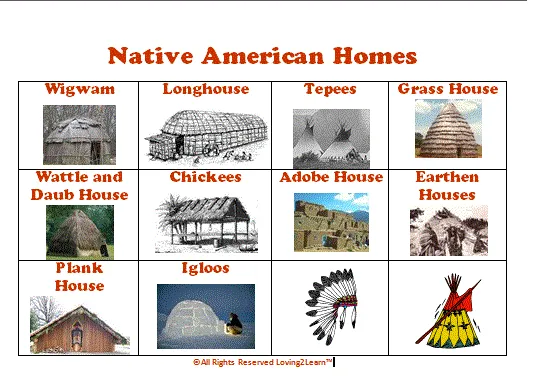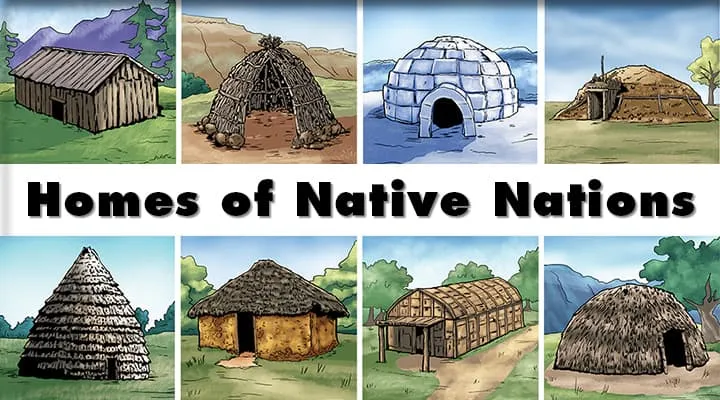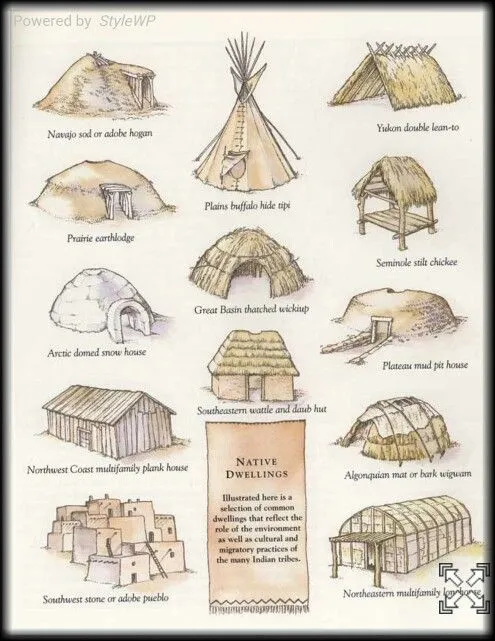In the mosaic of Native American cultures that once flourished across the vast expanse of North America, homes were not merely places of residence; they were living reflections of tradition, environment, and ingenuity.
The question that often arises is, “Just how many types of Native American houses existed?” Join Native American Clothes on a journey through the fascinating array of Indigenous dwellings, each a testament to the remarkable diversity of Indigenous peoples and their resourcefulness in adapting to their surroundings.
What is the most common type of Native American home?
When we think of Native American homes, our minds often conjure images of teepees, those iconic conical structures that have become synonymous with Indigenous culture. However, the truth is far more diverse and fascinating.
Native Americans, comprising a multitude of tribes across the continent, inhabited an array of distinctive dwellings, each ingeniously crafted to suit their unique environments and lifestyles. In this exploration, we peel back the layers of history to discover the remarkable variety of Native American homes, shedding light on their ingenious designs and the profound connection between architecture and nature.

Wigwams: Nature’s Abode
Let’s start with the wigwam, a term you may have heard before but might not fully grasp. Wigwams were a common sight in pre-colonial America, constructed with a harmonious blend of wood, saplings, and brush. These conical structures were far from the one-size-fits-all solution you might expect. Instead, Native American tribes adapted them to suit their particular needs and the landscapes they called home.
The Longhouse: A Communal Marvel
Imagine a dwelling not just as a home but as a community center. That’s precisely what the longhouse represents. Stretching far beyond the traditional family home, longhouses were communal structures built for extended families or even entire clans. Their impressive length and robust construction made them ideal for housing larger groups and fostering a sense of unity among the community.
Tipis: Nomadic Mastery
While teepees might be the most recognizable of Native American homes, they were not exclusive to all tribes. These portable abodes were ingeniously designed for a nomadic way of life, allowing tribes like the Plains Indians to move with the seasons, following the migration of buffalo herds. The tipi’s collapsible framework made it an emblem of efficiency and adaptability.
Igloos: Arctic Engineering
Head north, and you’ll discover the remarkable ingenuity of the Inuit people. In the icy landscapes of the Arctic, igloos were more than just shelters; they were feats of engineering. These dome-shaped structures, crafted from compacted snow blocks, provided insulation from the frigid temperatures, showcasing the intimate relationship between Indigenous peoples and their environments.
Pueblo Adobe Homes: Desert Resilience
In the arid Southwest, Native American tribes like the Puebloans created adobe homes that could withstand the scorching sun and occasional desert downpours. These multi-story structures, constructed from sun-dried bricks of earth and straw, were not only practical but also artistically adorned with intricate designs.
Grass Houses: Blending with Nature
Venture to the southeastern United States, and you’ll encounter yet another architectural wonder—the grass house. Constructed by tribes like the Seminoles, these homes seamlessly blended with the lush landscape, employing materials like palmetto leaves and thatch to create sturdy, nature-inspired shelters.
Plank Houses: A Coastal Haven
For coastal tribes of the Pacific Northwest, life revolved around the bounties of the sea. Their homes, known as plank houses, were an embodiment of their dependence on marine resources. Crafted from massive cedar planks, these structures were spacious, durable, and even resembled garages, offering ample storage for their prized canoes and fishing gear.
In exploring these diverse Native American dwellings, we gain not only a deeper understanding of their ingenious designs but also a profound appreciation for the deep connection these Indigenous peoples shared with their natural surroundings.
The architecture was not just about shelter; it was a testament to the adaptability, resourcefulness, and reverence for the land that defined Native American cultures. These homes were, and continue to be, a living testament to the enduring legacy of Native American traditions.
What is the name of a native house?

In the heart of Native American culture, where history and tradition intertwine with the land, the wigwam houses stand as iconic symbols of Indigenous ingenuity. In this exploration, we delve into the world of wigwams, also known as wickiups, unearthing the rich tapestry of these dome-like dwellings that have left an indelible mark on the Northeastern, Southwestern, and Western United States, as well as parts of Canada.
The Wigwam Legacy
Wigwams, or wickiups, were not merely shelters; they were reflections of Native American life and their deep connection to the environment. These dome-shaped dwellings, approximately 15 feet wide, varied in design and purpose based on their geographical location.
From Northeast to Central Canada: Wigwams of the North
In the Northeastern United States and parts of central Canada, the term “wigwam” became synonymous with these distinctive structures. Constructed primarily from trees and bark, the framing of these wigwams was typically the responsibility of the male head of the family. It was a meticulous process, where poles from trees were carefully bent and skillfully tied together to form the characteristic dome shape.
Southwestern and Western Wonders: Wickiups of the Desert
Venture further west, and you would encounter a slightly different term: “wickiups.” These were the counterparts to their northeastern cousins, found in the Southwestern and Western United States. Here, the landscape and available resources shaped the construction methods. The dome framework remained, but the choice of materials for the exterior covering varied, often including bark, grass, or rushes.
Beyond Shelter: A Glimpse into Native American Life
Wigwams and wickiups weren’t just places to lay one’s head; they were homes, rich in culture and tradition. Unlike the portable frames of teepees, the framework of these dome-shaped houses was firmly rooted in the ground, rendering them stationary. However, the coverings, which played a pivotal role in shielding inhabitants from the elements, could be easily replaced or repaired.
Women at the Helm: Keepers of the Wickiups
In the intricate tapestry of Native American life, the responsibility for the maintenance of wickiups often fell upon the shoulders of the women in the family. They were not only the homemakers but also the guardians of these unique structures. Women crafted the furnishings within the wigwam, adding a personal touch to their homes.
Moreover, when the exterior coverings showed signs of wear and tear, it was the women who skillfully repaired or replaced them, ensuring that the wigwams remained cozy sanctuaries.
As we journey through the history of Native American wigwam houses, we uncover not only the architectural marvels but also the stories and traditions that have been passed down through generations.
These dome-like dwellings continue to be symbols of resilience, adaptability, and the profound connection between Indigenous peoples and the land they called home. In every bend of the carefully crafted poles and in every replaced piece of bark or grass, we find a testament to the enduring legacy of Native American culture.
In the vast tapestry of Native American culture, homes were not just places to live; they were reflections of diverse traditions, lifestyles, and the environments in which various tribes thrived. Join us as we embark on a journey through the fascinating array of Native American homes, each a testament to resourcefulness and adaptability.
Diverse Dwellings: A Kaleidoscope of Native American Homes The Native American landscape was as varied as the cultures that inhabited it. Consequently, the homes they built were equally diverse. Here are some of the remarkable types of Native American homes that graced the North American continent:
1. Teepee: Iconic and Portable
The teepee, an instantly recognizable symbol of Native American culture, was a marvel of simplicity and functionality. Constructed with wooden poles and animal skins, it was not only easily assembled but also highly portable. This made it an ideal choice for nomadic Plains tribes like the Lakota and Cheyenne.
2. Wigwam: The Northeastern Shelter
Wigwams, also known as wickiups, were dome-like structures constructed from a framework of wooden poles, covered with materials like bark or grass. These were predominantly found in the Northeastern United States and parts of Canada. The framework was the domain of the male head of the family, while the maintenance of wickiups was a responsibility of the women.
3. Longhouse: Community-Centric Living
Longhouses were communal structures, often stretching up to 100 feet in length, accommodating multiple families or even an entire clan. Typically found in the Eastern Woodlands, these longhouses were constructed using a frame of wooden poles covered with bark sheets. They exemplified the strong sense of community among tribes like the Iroquois and Algonquin.
4. Chickee: Ingenious Seminole Shelters
In the swamps and wetlands of the Southeastern United States, the Seminole tribe crafted chickees. These unique homes featured raised platforms with open sides and thatched palmetto roofs, allowing air circulation to combat the stifling Florida heat and humidity.
5. Igloo: Arctic Adaptations
Far to the north, in the Arctic regions, the Inuit people ingeniously built igloos from blocks of snow and ice. These temporary shelters provided warmth and insulation against the frigid temperatures, demonstrating the remarkable adaptability of Indigenous peoples to their harsh environments.
6. Cliff Dwelling: Anasazi Marvels
The Anasazi tribe, ancestors of the modern Pueblo peoples, found refuge in cliff dwellings. Carved into the sheer rock faces of canyons in the American Southwest, these multi-story structures offered protection and a vantage point for observing potential threats.
Building Blocks: Materials that Shaped Homes
The materials used in Native American homes were a reflection of both the available resources and the environmental conditions of the region. They included:
– Wood: Abundant in many regions, wood was used for frames and support structures.
– Animal Skins: Bison hides, deer hides, and other animal skins were commonly used as coverings for teepees and other structures.
– Bark: Birch bark, in particular, was a valuable resource for covering and insulating homes.
– Mud and Clay: In areas with limited wood resources, mud and clay were used to construct walls and floors.
– Grass and Rushes: Thatched roofs and coverings were often made from local grasses and rushes.
– Rock: In regions with rocky terrain, tribes like the Anasazi built homes directly into cliff faces.
Native American homes were not just places of shelter; they were living embodiments of tribal identities, adaptable to the surrounding landscape and climate. From the iconic teepees of the Plains to the cliff dwellings of the Southwest, each dwelling told a unique story of Indigenous life in North America.
See more: Trend Printing Native American Designs And Patterns On Products
In these homes, traditions were passed down, families were nurtured, and communities thrived, leaving an indelible mark on the rich tapestry of Native American heritage.


